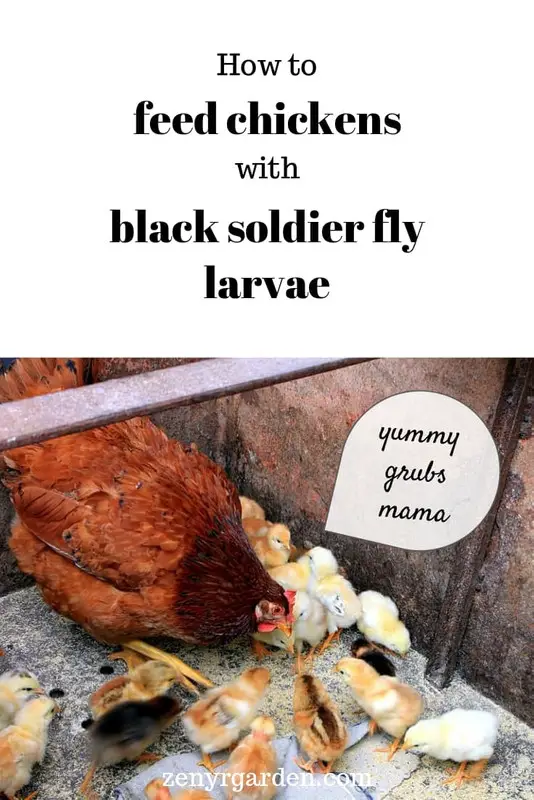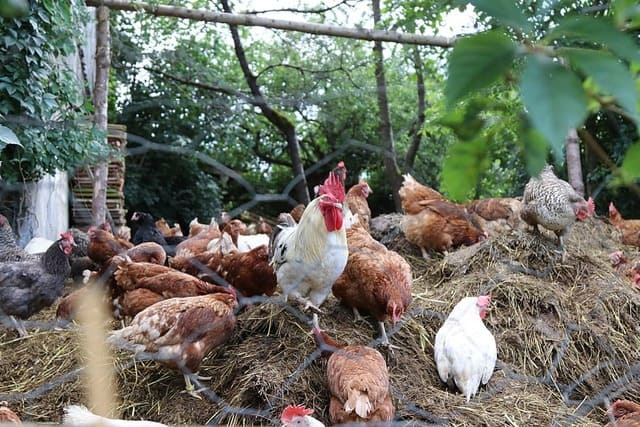When feeding black soldier fly larvae to little chicks, we're more careful about how much larvae to feed them. For bigger chicks, they'll do fine with big & small larvae. Actually your girls & guys will come running for these little treats. Let's see some ideas for how to feed them yummy BSF grubs.
Feeding BSF to Little Chicks
For chicks about 7-10 days old, people usually throw in some little BSF larvae in their feeding area. 5- or 7-days-old larvae are good for the little chicks because they are small so it's easier for chicks to chew. People feed the chicks the larvae this early so they can get used to the smell & taste.
What we should look out for is a protein overload. Although the BSF larvae contain a good amount of protein, we don't want too much yet for the baby chicks. Because an excess amount of protein may cause diarrhea or the chicks may excrete white poop.
In raising areas where there's too much protein, you may also notice an ammonia smell (as the protein breaks down). To help their young digestive system, mix in some little pebbles to make the foods easier to digest.
For chicks from 1 to 21 days old, we can combine:
- 1/3 BSF larvae
- 1/3 greens
- 1/3 seeds or grains
Using this ratio, you can feed them once a day. That'll be good enough at this stage. It's safer to filter out the poop of the larvae before feeding the chicks.
For 2-days-old larvae, the poop can be difficult to screen out. But for 5-days-old or older bigger larvae, this task is easier.
If the feeding substrate is wet, you can wait several days for the substrate to dry & don't add more water to it before harvesting the larvae. After 3-4 days, as the substrate dries you can use a sifter to sieve the remaining crumbled pieces out.
Alternatively, you can run the larvae under running water to wash off any remaining frass around their bodies.
Some people add digestive enzymes to help the young chicks digestion. It's good to feed them in the morning & less in the evening.
Notes On Feed Larvae to Chicks
The chitin amount actually develops more as the bsf larvae reaches their pre-pupae stage or have turned a bit more darkened. Chitin, as some farmers have shared with us, affects the nutrient digestion and absorption of monogastric animals. For example, it can cause protein binding in the animals' guts or digestive tracts, causing digestion problems.
For feeding, you could then choose larvae that are still cream or whitish to feed the chickens. About 12-day-old is a good point as they have not turned too dark yet. This will give chickens good nutrients while preventing the problem of chitin build-up.
Feeding BSF Larvae to Bigger Chickens
Bigger chickens from day 21 & older have no problems chewing BSF larvae. They actually love this stuff. People find that when you start feeding the chickens with these larvae, they actually turn 'nah thanks' to the pre-made chicken feed. When you put the two feeds (chicken feed vs bsf larvae) side by side, the chickens will come running for the BSF larvae.
If you have around 60-70 chickens, then mixing this amount of larvae will be good enough for them daily:
- 3 kg BSF larvae
- 1/3 greens
- 1/3 grains
So the question many people ask is why not feed the chickens 100% BSF larvae?
This is because a diet with 100% larvae may give the chickens too much protein than what their bodies need. As one BSF larvae contains nearly 40-45% protein inside their body. The nutrient is at its max especially if you use 12-day-old larvae that have turned not too dark. So it's like a dynamite of protein, which could be not good for the chicks.
Raising Chickens for Eggs (Layers)
If you're raising chickens for eggs, then too much protein will make them fat. When chickens are overly fat, they won't lay eggs as early. So for egg chickens, supplementing about 3% of BSF larvae in their diet will be good enough for them. With the calcium in the larvae, the eggs laid will have very strong and hard shells. Their yolks have a deep orange color & are not easy to break loose.
This is the same with quails. If you feed them 3-4 times/day with 100% BSF larvae, their reproduction system may get blocked. So we can balance out the diet with some cornmeal, greens or soybean meal to give them the starch, vitamins & fibers they need.
Raising Chickens for Meat (Broilers)
If you're raising chickens for meat, then 40-70% of BSF larvae in their diet will be nice. The chitin in the exoskeleton of the larvae helps build the chicken muscles & lowers the fat amount.
The chickens will develop extremely beautiful, smooth feathers. The risk of them poking into each other or the feathers falling off here and there will be lowered. Their immune system can get stronger. We then can worry less about their health & the money spent on probiotics.
For the most careful farmers, they pre-treat the larvae with microbial enzymes. This helps eat off any potentially harmful bacteria around the BSF larvae before the grubs get fed to the chickens.
If you have the rinds of mangosteen or guava leaves, try cooking those up and dilute them with water (to reduce the tartness). Add a bit of honey or sugar to make it easier for the chickens to drink. Give them some of the drink every morning. This stuff will keep their stomach strong & happy.
If you would like some general-purpose recipes, let's come check out:
General-Purpose BSF Feeding Recipes for Chicks (for Pellet Food)
Here are some general-purpose feeding recipes for the chickens:
1 month old
A bit more chicken feed at this point + supplementary small 5 to 7-day-old BSF larvae to help their young digestive system & avoid protein overload.
2 months old
- 5 kg/11 lbs corn
- 5 kg/11 lbs bran
- 8 kg/17 lbs BSF larvae
3 months old
- 5 kg BSF larvae + other grains and greens
Happy Chick Feeding
Hope this brief post has given you some ideas for feeding BSF larvae to the chicks. Good luck & have fun with watching your flock grow strong, healthy and beautiful.
>> Grubblies daily snack for chickens
Responses to Readers' Questions
the 1,2,3-month old chicken recipes above - that's for how many chickens?
--> Thanks for your question. To be clear, those recipes are for blending and pelletizing the chicken feed. I have made a note about it for clarity. When you blend/pelletize feed like this, you can add it to a feed distributor. The chickens may then consume the food themselves, as much as they feel at the time to get full energy. You can do the same with live BSF larvae and worry less about protein overload. With well-dried pellet feed, it can keep for 60 days. I hope this helps!
Note: For chickens a week old, you can start feeding them with larvae. Then gradually increase the amount. Don't feed too much cause too much protein may cause them diarrhea and death. If you notice diarrhea when feeding, stop the larvae at that point.
Share or pin this post!


